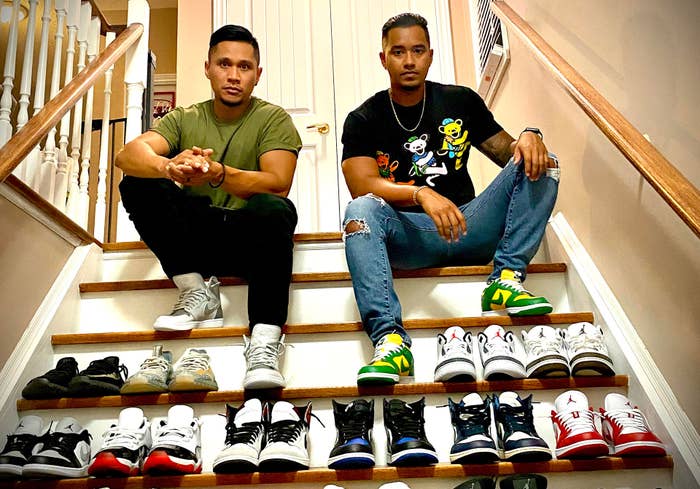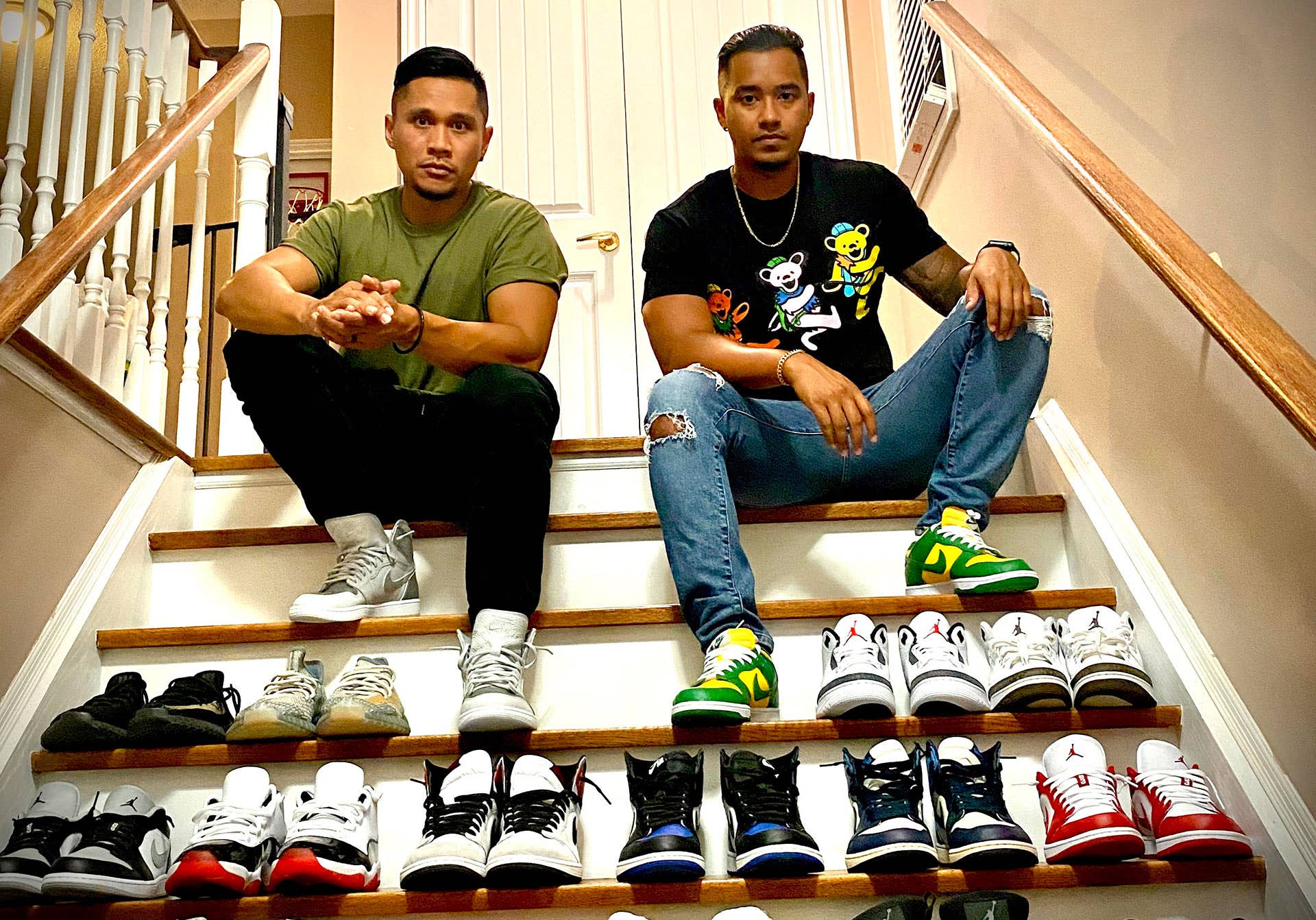
One of the best places to buy sneakers in Toronto is a deserted parking lot behind a laundromat in the west-end neighborhood of Parkdale. On a rainy afternoon in late August I rolled up there on my bike to meet David, who was standing by the trunk of his car wearing a pair of Rookie of the Years. I had connected with David over Kijiji that morning and arranged to buy some mildly scuffed-up Air Jordan 1s in the coveted “Turbo Green” colourway, and here he was, as promised, to make the deal. As we waited for my e-transfer to be completed—I was sending him a little over $300—a portly, middle-aged man in a business suit strolled by and nodded at the Nike box on the ground between us. “Got any other Jordans for sale?” he asked. “Lots,” David said. “What are you looking for?”
David is the proprietor of We Got Grails, a sneaker resale company he runs out of his living room with his brother in the Greater Toronto Area. Meeting up with eager local sneakerheads around the city, he buys, sells, and trades all kinds of new and used Jordans, Dunks, and Yeezys, advertising his wares on Facebook and Instagram and online marketplaces like Craigslist and Kijiji. The kinds of cash-for-kicks deals he coordinates with interested buyers like me are his bread and butter—and as the demand for rare sneakers continues to rise, businesses such as David’s are becoming more successful than ever. This is no longer about people lining up for shoes and flipping them on eBay for a tidy profit. The sneaker resale market has become a whole cottage industry, and in Canada, outfits like We Got Grails are cleaning up.
When COVID-19 hit in March, Shawn Alonto and Richard Chang suddenly found themselves with a whole lot of time and not much to do. One weekend, they happened to score a pair of Jordan 6 DMPs, and they were astonished to see how much people were willing to pay for them online. It gave them an idea: maybe they should start reselling. “That’s when we started our business, pretty much,” Richard, now the co-founder of Sneaker Source Toronto, told me on the phone recently.
“You have to be well-connected. Managers at Champs and Foot Locker will message me and say, ‘Hey, I just got this in, you have thirty minutes to get here.’ That’s how it works.” - Tyler a.k.a. Kicks1nthe6ix
For Richard and Shawn, progress was slow at first. “We had kind of stumbled on that first pair, and we didn’t know that it would be so hard to get them every time a new shoe was released,” Richard says. “We were just trying, manually, to grab as many pairs as we could, getting ready to wake up at 6 a.m. to try the Nike site, and again at 10 a.m. on Foot Locker. It was tough. That’s how it was for a while. Just straight online purchases, by ourselves, as hard as we could.”
If you have ever tried to buy a pair of hot sneakers in Canada, you know how incredibly frustrating it can be. You head to the Foot Locker site at launch time only to face slow load times, crashing web pages, and checkouts that hardly seem to work. The whole process seems unbelievably unfair. “Any site that releases a hot shoe is always going to crash because so many people are on there at once trying to get it,” Richard points out. “If you want to be successful as a manual purchaser, you have to be patient. Consistent and patient.” Some crashed sites reload eventually; some instant sell-outs repopulate hours later. It’s about learning the nuances and sticking with it.
Of course, there are more sophisticated methods available to the professional reseller, as Richard and Shawn soon learned. “At the beginning of this process we literally knew no one,” he says. “But eventually we made connections.” The two discovered what are known in the industry as “Cook Groups”—exclusive, underground networks of sellers that use computers to cheat the system and beat flesh-and-blood buyers to the chase. “These guys spend thousands of dollars building these bots, and then they sell access to the shoes to sellers like us for $20 or $30 a pop,” Richard explains. “Securing more than one pair of a hot shoe manually is virtually impossible. This way, we can get as many as we want, and we can mark up the price $50 or $100 per shoe depending on the demand.”
“Our clients now are the average sneaker lover, and a lot of them are young kids and students who don’t have the cash flow to spend $2000 on a shoe,” Shawn Alonto of Sneaker Source Toronto
Bots are an unfair advantage that normal consumers understandably loathe. Still, even with the leg up, sellers like Richard and Sean are taking on a lot of unavoidable risk. Some sneakers are almost guaranteed to sell at a massive premium: Jordan 1 Highs, most Yeezys, most Dunks. Everything else, though, is difficult to predict. “You never really know whether a sneaker is going to sell or whether it’s going to just sit there,” Sean says. He points to recent releases like the Jordan 12 in “Indigo” as examples of surprising duds. “You’re still able to go to Foot Locker and buy those. We thought they would sell quickly but they didn’t. So it’s a bit of a gambling game.”
Tyler, who resells under the name Kicks1nthe6ix (and asked to use an alias to preserve his anonymity) tells me he wasn’t surprised to see the Indigo wasn’t popular. “I could have told you that ahead of time,” he says. “The stock was really high, and the demand was fairly low, compared to the stock level.” Tyler has been studying the market for sneakers closely for long enough now that he can intuit what will or won’t be a worthwhile buy: “It really depends on the shoe. But once you’re immersed in it, you know how it’s going to perform. What’s it selling for on StockX? How has that kind of shoe performed in the past? How limited is the stock?” Some of this information, naturally, is hard to come by. For things like quantities, it’s all about who you know. “I know exactly how much stock Foot Locker has in the entire country right now,” he says.
When I reach Tyler on the phone, he’s on the highway, “running around all day from store to store buying shoes,” as he explains it. Although most shoes sell out the minute they’re released, small numbers will still arrive to stores in dribs and drabs in the days and weeks to come. You just need contacts on the inside to clue you in. “You have to be well-connected,” he says. “Managers at Champs and Foot Locker will message me and say, ‘Hey, I just got this in, you have thirty minutes to get here.’ That’s how it works.”
While Tyler’s day-to-day business is much like Richard, Shawn, and David’s, he has an eye, in particular, on the long term. As he puts it, the sneaker resale market is more complex than it might initially seem. “It’s like the stock market,” he says. “There are different perspectives. There are quick sales and there are long-term holds. Long-term investment strategies work really well.” Shoes that might sell “for a decent amount right away,” such as Court Purple Jordans or the recent Tokyo JPs, will appreciate in value in time. “If you’re comfortable holding on to something like that for two years, you can realistically double the investment,” he says. “You just have to make that decision when you’re buying the shoe. Is it a quick flip or a long haul? You do the equation from there.”
Tyler says he would love to have the capital and the time to make larger shoe investments: he insists it would be a smart move to snap up as many Jordan 1 Off-White Sails as possible now and hold on to them for 12 to 24 months, as their current $2000 price tag will continue to balloon. His current operation, however, is oriented around quick turnarounds and smaller margins: “I prefer volume and consistency right now,” he says. “That’s the way to go.” He hopes to some day turn his reselling business into a full-blown retail storefront, and is considering moving to the U.S., where the sneaker market is much easier on consumers and resellers alike.
Richard and Shawn agree. “Our clients now are the average sneaker lover, and a lot of them are young kids and students who don’t have the cash flow to spend $2000 on a shoe,” Shawn says. “We want to stay in that market. If we had the chance to buy an Off-White at a decent price, we’ll move them. But we don’t want to move into the hardcore sneakerhead territory where we’re spending $2000 on a shoe and getting $2200 for it.” The average sneaker, Richard points out, is luxurious enough. “The Jordan 1s are still expensive. $400 is a lot of money for a pair of shoes,” he says. “But I’d rather move 20 of those for $400 than two pairs of Off-Whites for ten times the price.”

